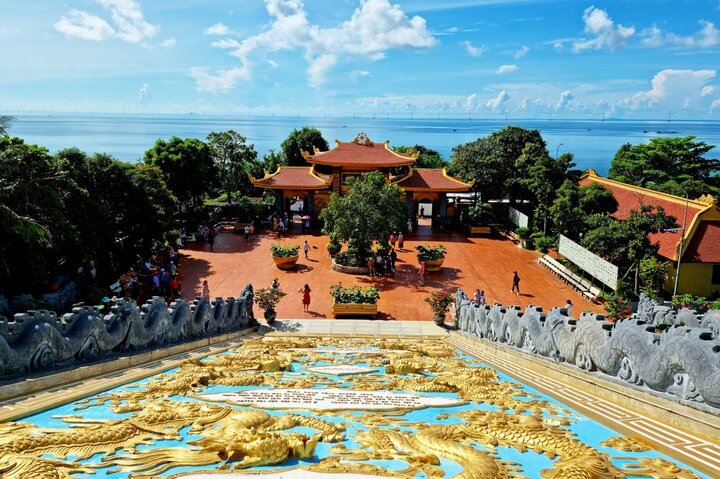1. Where is Ho Quoc Pagoda located?
Ho Quoc Pagoda, also known as Truc Lam Ho Quoc Zen Monastery, is situated in Suoi Lon Hamlet, Duong To Commune, Phu Quoc City, Kien Giang Province. It is the largest pagoda on the Pearl Island, nestled in a stunning natural setting with its back against the mountain and facing the sea.
The "mountain-back, sea-facing" terrain of Ho Quoc Pagoda (Photo: Collected)
The pagoda is conveniently located, just about 10 km from Phu Quoc Airport and 20 km from Duong Dong town center. Situated along Nguyen Van Cu Street – a main route connecting many popular attractions, Ho Quoc Pagoda is an ideal stop for travelers.
Open daily from 6:00 AM to 6:00 PM, visitors are free to explore and offer prayers. Built in 2011 and completed by the end of 2012, the pagoda spans a spiritual tourism complex of around 110 hectares, with the main structure occupying about 12% of that space. With an investment of over VND 100 billion, Ho Quoc Pagoda stands out as one of Vietnam's most grand and unique spiritual constructions.
2. The history of Ho Quoc Pagoda
Feng shui location of Ho Quoc Pagoda (Photo: Collected)
Ho Quoc Pagoda is not only a spiritual landmark in Phu Quoc but also carries deep historical significance. The name "Ho Quoc" means "Protect the Nation," symbolizing its mission in guarding the country’s borders and upholding national security. This name reflects patriotism and the spirit of homeland protection.
Key milestones in the pagoda's history:
October 14, 2011: Construction of Ho Quoc Pagoda began.
December 14, 2012: After 14 months of construction, the pagoda was officially inaugurated and opened to visitors.
2013–2014: Further developments were made, including landscape enhancements and visitor amenities. These additions helped attract a growing number of domestic and international tourists, contributing to Phu Quoc’s image as a spiritual tourism destination.
Since its completion, Ho Quoc Pagoda has become not only a religious symbol but also a cultural and historical landmark of the island. The harmonious blend of nature, architecture, and historical meaning offers visitors a serene retreat and a connection to valuable traditional values.
3. Explore the distinctive architecture of Ho Quoc Pagoda
Besides its impressive scale, Ho Quoc Pagoda captivates visitors with its elegant architecture, heavily inspired by the Ly-Tran dynasties. Every detail is carefully crafted, creating a perfect blend of ancient charm and natural grandeur.
3.1. Ly-Tran-inspired architectural style
One highlight of the pagoda’s architecture is the use of durable ironwood pillars as the main building material. Carefully selected, these ironwood beams can last for centuries, ensuring the structure’s strength and preserving traditional aesthetics. Intricate carvings on the wood reflect the Ly-Tran style, bringing a sense of both solemnity and warmth.
The unique architecture of Ho Quoc Pagoda (Photo: Collected)
3.2. Notable architectural features within the complex
- Three-Entrance Gate (Tam Quan): The grand entrance to the sacred space of the pagoda, consisting of three sections with symbolic meanings: the central Earth Enlightenment Gate, representing awakening; the left Insight Gate; and the right Liberation Gate, symbolizing the spiritual journey to inner peace.
- Heavenly Well Courtyard (San Thien Tinh): A spacious, airy courtyard just past the main gate, where a nearly 3-meter-tall Jade Buddha statue is enshrined. Crafted from rare jadeite, the statue is a symbol of purity and serenity.
- Main Hall (Chinh Dien): Visitors reach the main hall by ascending 70 stone steps, each adorned with patterns in Tran Dynasty style. Flanking the path are four stone dragons, representing sacred protection. Inside, the solemn worship space features embossed murals and statues of Buddhas and Arhats, illustrating Buddhist teachings and legends.
- Ancestral House (Nha To): This quiet, respectful space honors the Three Patriarchs (Nhan Tong, Phap Loa, Huyen Quang) who greatly contributed to the development of the Truc Lam Zen tradition. Visitors can feel the deep spiritual connection and reverence here.
With a design that harmoniously blends traditional and modern elements, Ho Quoc Pagoda is not only a place of worship but also a cultural site for discovering Vietnam's rich spiritual and architectural heritage.
Ho Quoc Pagoda as a sacred Zen destination on Pearl Island (Photo: Collected)
4. Tips for visiting Ho Quoc Pagoda
4.1. Offering prayers and seeking peace
A visit to Ho Quoc Pagoda isn’t complete without offering prayers. Simple offerings like incense, flowers, or fruits are commonly brought to express sincerity and wish for good fortune. Many come here to pray for family harmony, success, health, and happiness.
4.2. Enjoying the heavenly landscape
Perched between mountain and sea, Ho Quoc Pagoda offers panoramic views of lush forests and the vast ocean. The tranquil setting helps visitors find inner peace and relaxation.
Early mornings or late afternoons are the best times to visit, when the sunlight filters through the trees and gentle waves create a dreamy, serene atmosphere.
4.3. Learning about culture and history
Exploring the Main Hall, Ancestral House, and intricate bas-reliefs offers insights into Buddhist philosophy and Vietnam’s spiritual history. Guided tours are available for groups, providing detailed explanations of the site’s cultural and historical value.
On special occasions like the 1st and 15th of each lunar month, Tet (Lunar New Year), or Vu Lan Festival (7th lunar month), the pagoda becomes a vibrant spiritual gathering place, where visitors and locals offer incense, pray for peace, honor ancestors, and join traditional ceremonies.
5. How to get to Ho Quoc Pagoda in Phu Quoc
Panoramic view of Truc Lam Ho Quoc Zen Monastery (Photo: Collected)
Here are detailed directions from popular locations on the island to Ho Quoc Pagoda:
From Phu Quoc Airport: Exit the airport and take the Phu Quoc Highway, then turn right onto Nguyen Van Cu Street. Drive straight for about 9 km until a large curve, make a U-turn, and continue for another 3 km to reach the pagoda. The trip takes around 20 minutes by car or motorbike.
From Duong Dong Town Center: From central Duong Dong, take Cach Mang Thang Tam Street for about 200 meters, then turn into Duong Dong or DT45 Road. Continue for 2 km, then merge into TL47 Road. Follow it for 8 km until the large roundabout, take the second exit onto Nguyen Van Cu Street, and go 11 km. Near Montana Resort, continue for 1.5 km to reach the pagoda. Travel time is about 30–40 minutes.
From Southern Phu Quoc (An Thoi area): From An Thoi or nearby resorts like JW Marriott Phu Quoc Emerald Bay or Premier Residences, take Nguyen Van Cu Street north for 7.5 km. Turn right at Guest House Blue Sea 68, then continue for 4.5 km. The journey takes about 20–25 minutes by car or motorbike.
From Northern Phu Quoc: From the north, the distance is around 50 km. Take the main road from Cua Can or Ganh Dau for about 20 km, then turn onto TL47. Continue straight for 8 km to the large roundabout, take the second exit to Nguyen Van Cu Street, and go 12.5 km. Due to the longer distance, hiring a car is recommended for safety and convenience.
6. Important notes for your visit
When visiting Ho Quoc Pagoda, keep the following in mind to ensure a smooth and respectful experience:
Maintain silence and respect the sacred atmosphere.
Dress modestly; avoid overly short, revealing, or flashy clothing.
Refrain from loud conversations or jokes, especially in the Main Hall.
Visit early in the morning or late afternoon to avoid the midday heat.
Bring a camera or binoculars for sightseeing, and prepare sun protection like hats and sunscreen.
Keep the area clean by not littering; carry a small trash bag for waste.
Be careful on stone steps and paths to avoid slipping. There is a spacious parking area available for cars.
With its stunning location, distinctive architecture, and peaceful atmosphere, Ho Quoc Pagoda is undoubtedly a must-visit destination on your journey to explore Phu Quoc.



